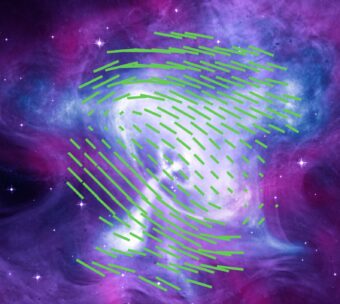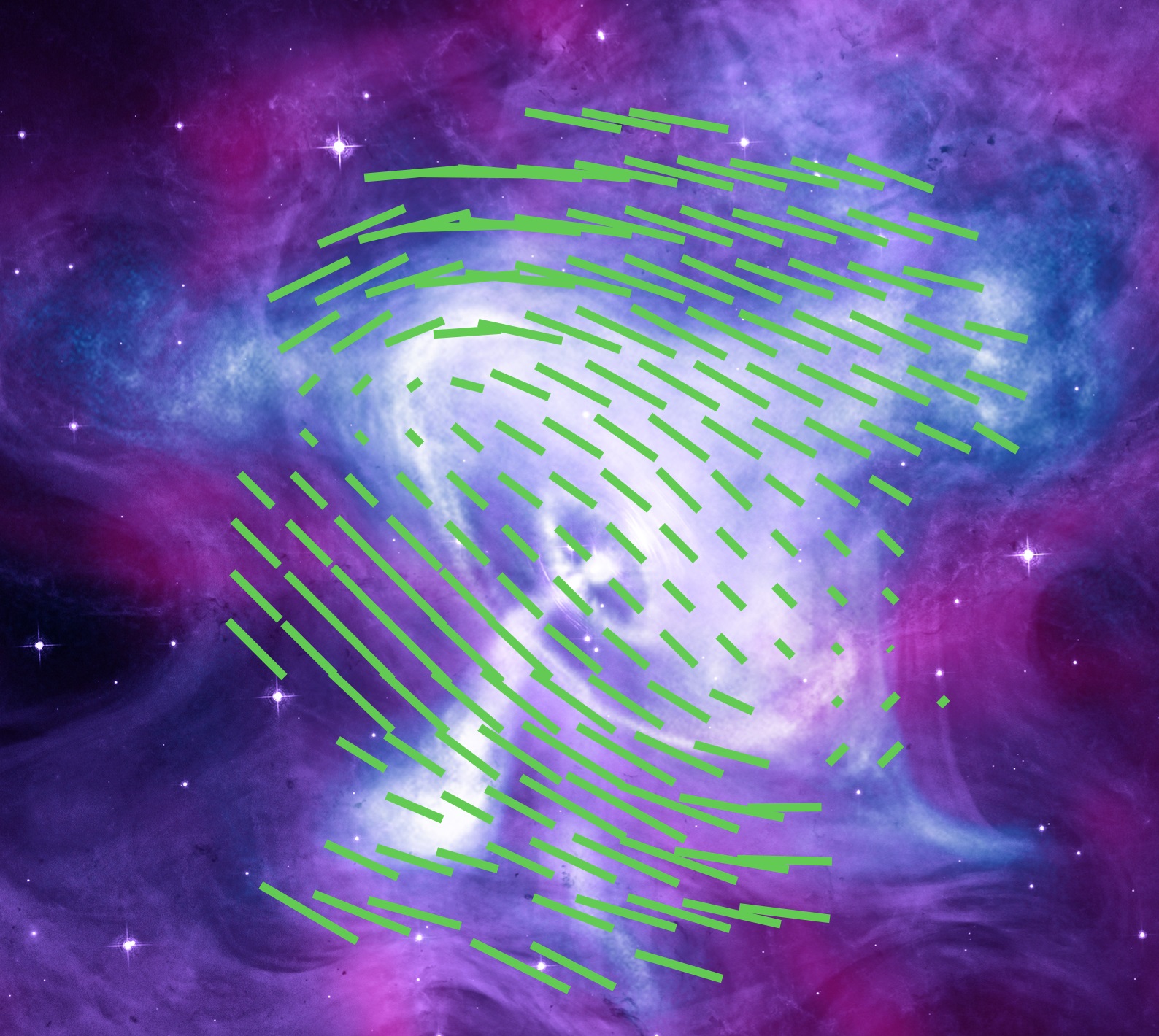
Image of the Crab Nebula observed in X-rays by the Chandra Space Telescope. The green bars indicate the structure of the nebula’s magnetic field as measured by the IXPE mission. Credits: Chandra/Nasa/Ixpe/Bucciantini et al.
The Imaging X-ray Polarimetry Explorer (Ixpe) space telescope, born from the collaboration between NASA and the Italian Space Agency (ASI), observed the heart of the Crab Nebula and thanks to the study of polarized X-ray emission it allowed to reconstruct for the first time the structure of the magnetic field. The high-resolution observations from Ixpe also allowed the first identification of polarized X-ray emission from the pulsar within the nebula. These results shed new light on the internal structure of this system, where particles are accelerated to high energies and non-thermal radiation is produced, and at the same time place important constraints on the current theoretical models describing the behavior of the pulsar and the surrounding nebula. .
The Crab pulsar and its nebula are among the most studied astrophysical systems and constitute one of the most fascinating and promising environments where high-energy cosmic phenomena such as particle acceleration, relativistic plasma physics and non-thermal processes can be observed. They were born together – the Crab nebula and pulsar – from the explosion of a supernova observed in China on the night of July 4, 1054and share other firsts: first object in the Messier Catalog, first identified supernova remnant, first source of synchrotron radiation, first identified radio source with an optical counterpart, just to name a few.
Since the launch of the Oso-8 satellite in 1975, the Crab Nebula has been the first and for a long time the only X-ray source whose polarization was detected. Polarization in synchrotron sources, where the radiation is produced by relativistic electrons spiraling in a magnetic field, suggests to scientists in which direction the average magnetic field is oriented, and in part how ordered this magnetic field itself is. X-rays, on the other hand, come from the same regions where those electrons are accelerated.
Launched into space on December 9, 2021, Ixpe is a mission entirely dedicated to the study of the universe through the measurement of X-ray polarization. It uses three telescopes installed on board with detectors funded by ASI and developed by a team of scientists from the Institute National Institute of Nuclear Physics (Infn) and the National Institute of Astrophysics (Inaf), with the industrial support of Ohb-Italia.
New findings from the first Ixpe observation of the Crab nebula and pulsar are presented in the study published today in the journal Nature Astronomy. The international team of researchers who signed the study is led by Niccolo Bucciantini of INAF who explains: “These unprecedented results demonstrate that X-ray polarimetry offers us a unique opportunity to directly investigate the still poorly understood physical conditions that lead to particle acceleration, in a way that no other technique allows you to do”.
«The long-awaited new measurement of the X-ray polarization of the Crab nebula arrives today thanks to the Gas Pixel Detector detectors designed in the Infn laboratories. After confirming in 2020, with the PolarLight nanosatellite, the historical measurement of 1975 of the average properties of the source, these devices allowed Ixpe to obtain the first detailed map of the magnetic field of the region, starting from the map of the polarization of the emitted radiation”. , explains Luca BaldiniInfn researcher at the University of Pisa.
“Ixpe confirmed the result previously obtained with the OSO-8 satellite and gave us unique insights into the physics at play in this class of sources,” he says. Andrea Marinucci, program manager Asis of Ixpe.
Together with the high-resolution images taken by NASA’s Chandra X-ray observatory in the past, it is now possible to obtain a more coherent and detailed image of this object. The internal magnetic field shows a well-defined “toroidal” structure, wrapping itself around the donut-like nebula, with local regions at a very high level of polarization: typical indication of weak turbulence.
Contrary to expectations, the distribution of turbulence appears more irregular than previously thought. «This is a clear indication that even the most complex models developed in the past with the use of advanced numerical techniques, had not fully grasped the complexity of this object» specifies Bucciantini.
The high resolution of the Ixpe observations also allowed the scientists to ‘isolate’ the emission from the central pulsar from that of the surrounding nebula. This X-ray emission probably originates in the pulsar’s magnetosphere but – more than fifty years after the pulsar’s discovery – exactly where and how remains a mystery.
Today the most accredited models that describe the behavior of this system favor emissions from the so-called “wind region” more than 1500 km away from the pulsar. While Ixpe’s measurements do not fully match any of the current models, they appear to disagree less with models that predict the emission to come from distant regions (the wind) than with those that argue for an origin in the inner magnetosphere.
As often in the past, this time too, with the opening of a new observation window, old questions have been resolved but new challenges await scientists on the Crab nebula and pulsar, which have once again revealed themselves to be an unsolved and rich mystery of answers waiting to be discovered.
To know more:
- The article “Simultaneous space and phase resolved X-ray polarimetry of the Crab Pulsar and Nebula” by Niccolò Bucciantini, Riccardo Ferrazzoli, Matteo Bachetti, John Rankin, Niccolò Di Lalla, Carmelo Sgrò, Nicola Omodei, Takao Kitaguchi, Tsunefumi Mizuno, Shuichi Gunji, Eri Watanabe, Luca Baldini, Patrick Slane, Martin C. Weisskopf, Roger W. Romani, Andrea Possenti, Herman L. Marshall, Stefano Silvestri, Luigi Pacciani, Michela Negro, Fabio Muleri, Emma de Oña Wilhelmi, Fei Xie, Jeremy Heyl, Melissa Pesce-Rollins, Josephine Wong, Maura Pilia, Iván Agudo, Lucio A. Antonelli, Wayne H. Baumgartner, Ronaldo Bellazzini, Stefano Bianchi, Stephen D. Bongiorno, Raffaella Bonino, Alessandro Brez, Fiamma Capitanio, Simone Castellano, Elisabetta Cavazzuti, Chien-Ting Chen, Stefano Ciprini, Enrico Costa, Alessandra De Rosa, Ettore Del Monte, Laura Di Gesu, Alessandro Di Marco, Immacolata Donnarumma, Victor Doroshenko, Michal Dovčiak, Steven R. Ehlert, Teruaki Enoto, Yuri Evangelista, Sergio Fabiani, Javier A. Garcia, Kiyoshi Hayashida, Wataru Iwakiri, Svetlana G. Jorstad, Philip Kaaret, Vladimir Karas, Fabian Kislat, Jeffery J. Kolodziejczak, Henric Krawczynski, Fabio La Monaca, Luca Latronico, Ioannis Liodakisu, Simone Maldera, Alberto Manfreda, Frédéric Marin, Andrea Marinucci, Alan P. Marscher, Francesco Massaro, Giorgio Matt, , Ikuyuki Mitsuishi, C.-Y. Ng, Stephen L. O’Dell, Chiara Oppedisano, Alessandro Papitto, George G. Pavlov, Abel L. Peirson, Matteo Perri, Pierre-Olivier Petrucci, Juri Poutanen, Simonetta Puccetti, Brian D. Ramsey, Ajay Ratheesh, Oliver J. Roberts, Paolo Soffitta, Gloria Spandre, Doug Swartz, Toru Tamagawa, Fabrizio Tavecchio, Roberto Taverna, Yuzuru Tawara, Allyn F. Tennant, Nicolas E. Thomas, Francesco Tombesi, Alessio Trois, Sergey Tsygankov, Roberto Turolla, Jacco Vink, Kinwah Wu , Silvia Zane was published today in the magazine Nature Astronomy.
Watch the interview with Niccolò Bucciantini on MediaInaf TV:

